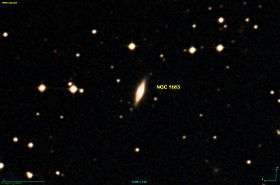NGC 1683
| NGC 1683 | |
|---|---|
 DSS image of NGC 1683 | |
| Observation data (J2000 epoch) | |
| Constellation | Orion |
| Right ascension | 04h 52m 17.639s[1] |
| Declination | −03° 01′ 27.96″[1] |
| Redshift | 3941 km/s[2] |
| Helio radial velocity | 0.013146[2] |
| Distance | 175.1 Mly (53.69 Mpc)[3] |
| Apparent magnitude (B) | 15.58[4] |
| Characteristics | |
| Type | Sa? pec sp[2] |
| Apparent size (V) | 1.2′ × 0.4′[2] |
| Other designations | |
| NGC 1683, PGC 16209[5] | |
NGC 1683[2][6] is a spiral galaxy in the constellation Orion. The object was discovered in 1850 by the Irish astronomer William Parsons.
See also
References
- 1 2 Skrutskie, M.; et al. (2006). "The Two Micron All Sky Survey (2MASS)". The Astronomical Journal. 131 (2): 1163–1183. Bibcode:2006AJ....131.1163S. doi:10.1086/498708.
- 1 2 3 4 5 "NED results for object NGC 1683". NASA/IPAC Extragalactic Database. National Aeronautics and Space Administration / Infrared Processing and Analysis Center. Retrieved 10 May 2018.
- ↑ Crook, Aidan C.; Huchra, John P.; Martimbeau, Nathalie; Masters, Karen L.; Jarrett, Tom; Macri, Lucas M. (2007). "Groups of Galaxies in the Two Micron All Sky Redshift Survey". The Astrophysical Journal. 655 (2): 790–813. arXiv:astro-ph/0610732. Bibcode:2007ApJ...655..790C. doi:10.1086/510201.
- ↑ Jones, D. Heath; et al. (October 2009), "The 6dF Galaxy Survey: final redshift release (DR3) and southern large-scale structures", Monthly Notices of the Royal Astronomical Society, 399 (2): 683–698, arXiv:0903.5451, Bibcode:2009MNRAS.399..683J, doi:10.1111/j.1365-2966.2009.15338.x
- ↑ "NGC 1683". SIMBAD. Centre de données astronomiques de Strasbourg. Retrieved 10 May 2018.
- ↑ Frommert, Hartmut. "NGC 1683". spider.seds.org. Retrieved 2018-04-13.
This article is issued from
Wikipedia.
The text is licensed under Creative Commons - Attribution - Sharealike.
Additional terms may apply for the media files.